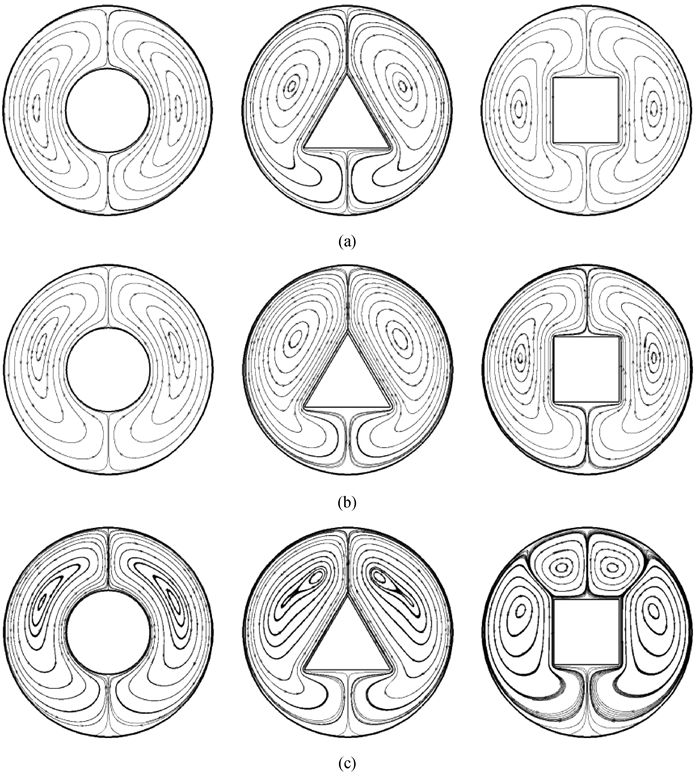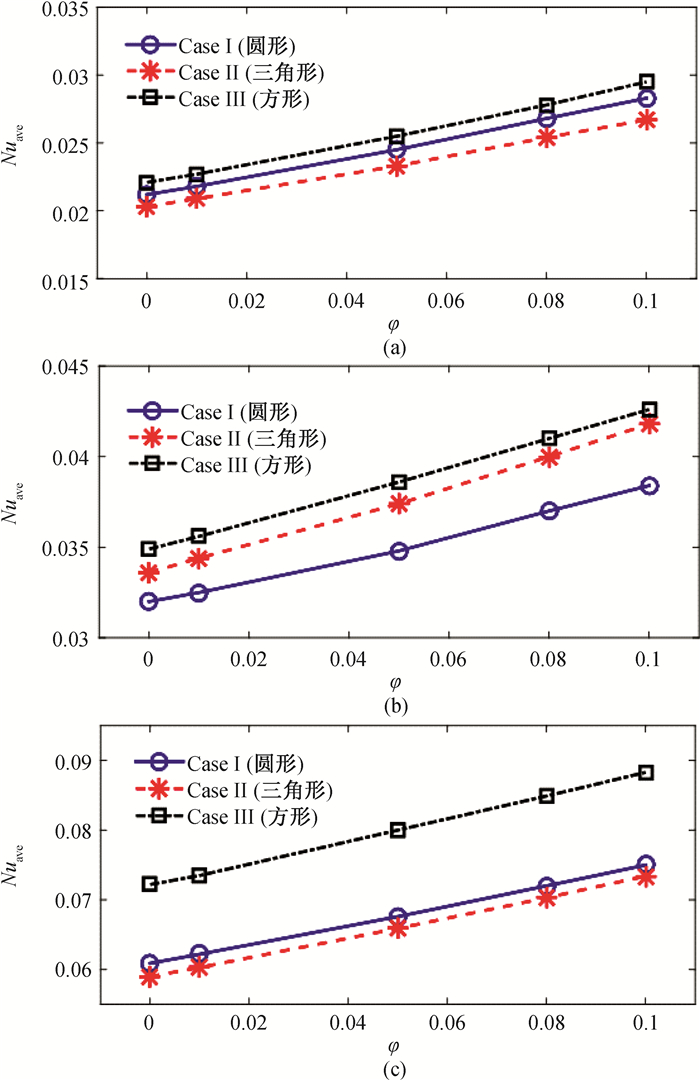计算物理 ›› 2021, Vol. 38 ›› Issue (3): 301-312.DOI: 10.19596/j.cnki.1001-246x.8244
收稿日期:2020-06-18
出版日期:2021-05-25
发布日期:2021-09-30
通讯作者:
娄钦
作者简介:唐古月, 男, 硕士, 主要从事格子Boltzmann方法数值模拟研究
基金资助:
Guyue TANG1,2, Qin LOU1,2,*( ), Haoyuan WANG1,2
), Haoyuan WANG1,2
Received:2020-06-18
Online:2021-05-25
Published:2021-09-30
Contact:
Qin LOU
摘要:
采用格子玻尔兹曼方法对有三种恒温热源(圆形、三角形、方形)参与的圆管内纳米流体(铜-水)自然对流进行数值研究。主要研究瑞利(Ra)数,纳米颗粒体积分数以及热源几何形状等控制参数对纳米流体的流动与传热的影响。结果发现纳米颗粒体积分数的增加有利于强化传热,且在Ra数较小时,平均努塞尔(Nu)数增加的幅度要优于Ra数较大的情况。在所研究的控制参数范围内,方形热源的平均Nu数最大。根据数值结果给出不同热源表面的平均Nu数、纳米颗粒体积分数、Ra数三者之间的函数关系式,该函数关系可为此类工程的设计提供理论指导。
中图分类号:
唐古月, 娄钦, 王浩原. 含不同形状内热源的圆管内纳米流体自然对流及换热数值研究[J]. 计算物理, 2021, 38(3): 301-312.
Guyue TANG, Qin LOU, Haoyuan WANG. Numerical Study on Natural Convective Flow and Heat Transfer of Nanofluids in a Circular Tube Containing Heat Source with Different Shape[J]. Chinese Journal of Computational Physics, 2021, 38(3): 301-312.
| ρ/(kg·m-3) | cp/(J·kg-1·K-1) | k/(W·m-1·K-1) | β/K-1 | |
| 水 | 997.1 | 4 179 | 0.613 | 21×10-5 |
| 铜 | 8 933 | 385 | 401 | 1.67×10-5 |
表1 纯水和铜固体颗粒的热物理性质
Table 1 Thermo-physical properties of pure water and Cu solid particles
| ρ/(kg·m-3) | cp/(J·kg-1·K-1) | k/(W·m-1·K-1) | β/K-1 | |
| 水 | 997.1 | 4 179 | 0.613 | 21×10-5 |
| 铜 | 8 933 | 385 | 401 | 1.67×10-5 |

图3 不同内管热源形状对应的流线分布(a)Ra=104;(b)Ra=105;(c)Ra=106
Fig.3 Streamline distributions with different inner tube heat source shape (a)Ra=104; (b)Ra=105; (c)Ra=106

图4 不同内管热源形状对应的等温线分布(a)Ra=104;(b)Ra=105;(c)Ra=106
Fig.4 Isotherm distributions with different inner tube heat source shapes (a)Ra=104; (b)Ra=105; (c)Ra=106

图6 纳米颗粒体积分数对局部Nu数分布的影响(a) Case I (圆形);(b) Case II (三角形);(c) Case III (方形)
Fig.6 Effect of nanoparticle volume fraction on local Nusselt number distribution (a) Case I (circle); (b) Case II (triangle); (c) Case III (square)

图7 不同纳米颗粒体积分数下各热源表面的Nuave (a)Ra=104;(b)Ra=105;(c)Ra=106
Fig.7 Nuave at heat source surface as functions of nanoparticle volume fractions (a)Ra=104; (b)Ra=105; (c)Ra=106
| Nuave | 最大误差(δmax)/% | 最小误差(δmin)/% | |
| Case 1 (圆形) | 0.0031 Ra0.241 8φ0.078 2 | 15.16 | 0.22 |
| Case 2 (三角形) | 0.0036 Ra0.230 9φ0.082 9 | 7.17 | 0.88 |
| Case 3 (方形) | 0.0024 Ra0.272 5φ0.077 8 | 16.33 | 0.21 |
表2 在给定的控制参数范围内(104≤Ra≤106,0.01≤φ≤0.1)拟合函数以及其与模拟数据的最大偏差(δmax)和最小偏差(δmin)
Table 2 Fit function within a given range of control parameters(104≤Ra≤106, 0.01≤φ≤0.1), as well as its maximum(δmax) and minimum deviation(δmin) from the simulated data
| Nuave | 最大误差(δmax)/% | 最小误差(δmin)/% | |
| Case 1 (圆形) | 0.0031 Ra0.241 8φ0.078 2 | 15.16 | 0.22 |
| Case 2 (三角形) | 0.0036 Ra0.230 9φ0.082 9 | 7.17 | 0.88 |
| Case 3 (方形) | 0.0024 Ra0.272 5φ0.077 8 | 16.33 | 0.21 |
| 1 | CHOL S U S. Enhancing thermal conductivity of fluids with nanoparticles[C]//ASME-Publications-Fed, 1995, 231: 99-106. |
| 2 |
KHANAFER K, VAFAI K, LIGHTSTONE M. Buoyancy-driven heat transfer enhancement in a two-dimensional enclosure utilizing nanofluids[J]. International Journal of Heat and Mass Transfer, 2003, 46 (19): 3639- 3653.
DOI |
| 3 |
KEFAYATI G R. Lattice Boltzmann simulation of natural convection in nanofluid-filled 2D long enclosures at presence of magnetic field[J]. Theoretical and Computational Fluid Dynamics, 2013, 27 (6): 865- 883.
DOI |
| 4 |
MAHMOODI M. Numerical simulation of free convection of a nanofluid in L-shaped cavities[J]. International Journal of Thermal Sciences, 2011, 50 (9): 1731- 1740.
DOI |
| 5 |
SOURTIJI E, HOSSEINIZADEH S F. Heat transfer augmentation of magnetohydrodynamics natural convection in L-shaped cavities utilizing nanofluids[J]. Thermal Science, 2012, 16 (2): 489- 501.
DOI |
| 6 |
IZADI M, MOHEBBI R, KARIMI D, et al. Numerical simulation of natural convection heat transfer inside a perpendicular to shaped cavity filled by MWCNT-Fe3O4/water hybrid nanofluids using LBM[J]. Chemical Engineering and Processing-Process Intensification, 2018, 125, 56- 66.
DOI |
| 7 | 张晶, 白国君, 马文强, 等. 粘度模型对U型封闭腔内AI2O3-水纳米流体自然对流的影响[J]. 甘肃科学学报, 2017, 29 (5): 110- 115. |
| 8 |
KALIDASAN K, KANNA P R. Natural convection on an open square cavity containing diagonally placed heaters and adiabatic square block and filled with hybrid nanofluid of nanodiamond-cobalt oxide/water[J]. International Communications in Heat and Mass Transfer, 2017, 81, 64- 71.
DOI |
| 9 |
WANG L, CHAI Z, SHI B. Regularized lattice Boltzmann simulation of double-diffusive convection of power-law nanofluids in rectangular enclosures[J]. International Journal of Heat and Mass Transfer, 2016, 102, 381- 395.
DOI |
| 10 |
WANG L, SHI B, CHAI Z. Effects of temperature-dependent properties on natural convection of nanofluids in a partially heated cubic enclosure[J]. Applied Thermal Engineering, 2018, 128, 204- 213.
DOI |
| 11 |
WANG L, HUANG C, YANG X. Effects of temperature-dependent properties on natural convection of power-law nanofluids in rectangular cavities with sinusoidal temperature distribution[J]. International Journal of Heat and Mass Transfer, 2019, 128, 688- 699.
DOI |
| 12 |
HE Y R, QI C, HU Y W, et al. Lattice Boltzmann simulation of alumina-water nanofluid in a square cavity[J]. Nanoscale Research Letters, 2011, 6 (1): 184.
DOI |
| 13 |
SHEIKHOLESLAMI M, GORJI-BANDPY M, DOMAIRRY G. Free convection of nanofluid filled enclosure using lattice Boltzmann method (LBM)[J]. Applied Mathematics and Mechanics-English Edition, 2013, 34 (7): 833- 846.
DOI |
| 14 |
MEHRIZI A A, FARHADI M, AFROOZI H H, et al. Mixed convection heat transfer in a ventilated cavity with hot obstacle: Effect of nanofluid and outlet port location[J]. International Communications in Heat and Mass Transfer, 2012, 39 (7): 1000- 1008.
DOI |
| 15 |
SEBDANI S M, MAHMOODI M, HASHEMI S M. Effect of nanofluid variable properties on mixed convection in a square cavity[J]. International Journal of Thermal Sciences, 2012, 52, 112- 126.
DOI |
| 16 |
MA Y, RASHIDI M M, MOHEBBI R, et al. Nanofluid natural convection in a corrugated solar power plant using the hybrid LBM-TVD method[J]. Energy, 2020, 199, 117402.
DOI |
| 17 | ABBASSI M A, SAFAEI M R, DJEBALI R, et al. LBM simulation of free convection in a nanofluid filled incinerator containing a hot block[J]. International Journal of Heat and Mass Transfer, 2018, 144, 172- 185. |
| 18 | AFSANEH R, KHOSROW J, EBRAHIM G R. Numerical investigation of pool nucleate boiling in anofluid with lattice Boltzmann method[J]. Journal of Theoretical and Applied Mechanics, 2016, 54 (3): 811- 825. |
| 19 |
KHANAFER K, VAFAI K, LIGHTSTONE M. Buoyancy-driven heat transfer enhancement in a two-dimensional enclosure utilizing nanofluids[J]. International Journal of Heat and Mass Transfer, 2003, 46 (19): 3639- 3653.
DOI |
| 20 | KAMYAR A, SAIDUR R, HASANUZZAMAN M. Application of computational fluid dynamics (CFD) for nanofluids[J]. International Journal of Heat and Mass Transfer, 2012, 55 (15/16): 4104- 4115. |
| 21 | WANG X Q, MUJUMDAR A S. Heat transfer characteristics of nanofluids: A review[J]. International Journal of Thermal Sciences, 2007, 45 (1): 1- 19. |
| 22 | REA U, MCKRELL T, HU L W, et al. Laminar convective heat transfer and viscous pressure loss of alumina-water and zirconia-water nanofluids[J]. International Journal of Heat and Mass Transfer, 2009, 52 (7/8): 2042- 2048. |
| 23 |
MAXWELL-GARNETT J C. Colours in metal glasses and in metallic films[J]. Philosophical Transactions of the Royal Society of London, Series A, 1904, 203, 385- 420.
DOI |
| 24 |
BRINKMAN H C. The viscosity of concentrated suspensions and solutions[J]. Journal of Chemical Physics, 1952, 20 (4): 571- 581.
DOI |
| 25 |
GRAY D D, GIORGINI A. The validity of the boussinesq approximation for liquids and gases[J]. International Journal of Heat and Mass Transfer, 1976, 19 (5): 545- 551.
DOI |
| 26 |
LI Q, HE Y L, WANG Y, et al. An improved thermal lattice Boltzmann model for flows without viscous heat dissipation and compression work[J]. International Journal of Modern Physics C, 2008, 19 (1): 125- 150.
DOI |
| 27 | LOU Q, ZANG C, WANG H, et al. Interfacial dynamics of immiscible gas-liquid two-phase flow for CO2 in Microchannel: Lattice Boltzmann method[J]. Chinese J Comput Phys, 2019, 32 (2): 153- 164. |
| 28 | NIE D M, LIN J Z, HUANG L Z. Lattice-Boltzmann investigation of rotating turbulence[J]. Chinese J Comput Phys, 2013, 30 (1): 11- 18. |
| 29 | TAO S, ZHOU L, ZONG Z. Multi-block lattice Boltzmann method for flows around two tandem rotating circular cylinders[J]. Chinese J Comput Phys, 2013, 30 (2): 159- 168. |
| 30 | XIE C Y, ZHANG J Y, WANG M R. Lattice Boltzmann modeling of non-Newtonian multiphase fluid displacement[J]. Chinese J Comput Phys, 2016, 33 (2): 147- 155. |
| 31 |
CHOPARD B, FALCONE J L, LATT J. The lattice Boltzmann advection-diffusion model revisited[J]. Eur Phys J Special Topics, 2009, 171, 245- 249.
DOI |
| 32 |
CHAI Z, ZHAO T S. Lattice Boltzmann model for the convection-diffusion equation[J]. Physical Review E, 2013, 87 (6): 063309.
DOI |
| 33 |
ZHANG T, SHI B C, GUO Z L, et al. General bounce-back scheme for concentration boundary condition in the lattice-Boltzmann method[J]. Physical Review E, 2012, 85 (1): 016701.
DOI |
| 34 |
GANGAWANE K M. Computational analysis of mixed convection heat transfer characteristics in lid-driven cavity containing triangular block with constant heat flux: Effect of Prandtl and Grashof numbers[J]. International Journal of Heat and Mass Transfer, 2017, 105, 34- 57.
DOI |
| 35 |
GANGAWANE K M, BHARTI R P, KUMAR S. Effects of heating location and size on natural convection in partially heated open-ended enclosure by using lattice Boltzmann method[J]. Heat Transfer Engineering, 2016, 37 (6): 507- 522.
DOI |
| [1] | 袁俊杰, 叶欣, 单彦广. 格子Boltzmann方法模拟填充纳米流体三角形腔内的自然对流[J]. 计算物理, 2021, 38(1): 57-68. |
| [2] | 周璐, 马红和. 抛物槽式太阳能集热器内合成油基纳米流体传热特性的数值模拟[J]. 计算物理, 2021, 38(1): 99-105. |
| [3] | 周陆军, 宣益民, 李强. 纳米流体多相流动的多尺度模拟方法[J]. 计算物理, 2009, 26(6): 849-856. |
| [4] | 曹炳阳. 一种模拟热导率的非平衡分子动力学方法[J]. 计算物理, 2007, 24(4): 463-466. |
| 阅读次数 | ||||||
|
全文 |
|
|||||
|
摘要 |
|
|||||
版权所有 © 《计算物理》编辑部
地址:北京市海淀区丰豪东路2号 邮编:100094 E-mail:jswl@iapcm.ac.cn
本系统由北京玛格泰克科技发展有限公司设计开发
